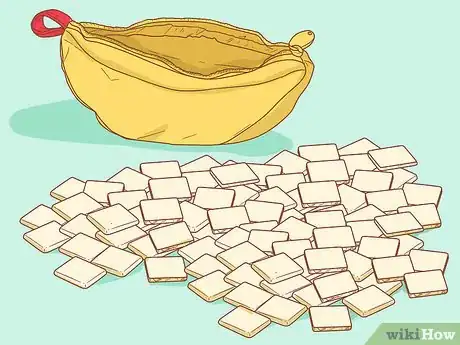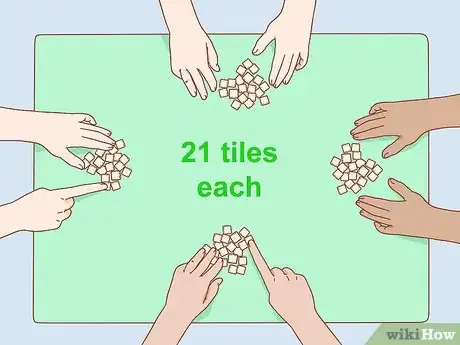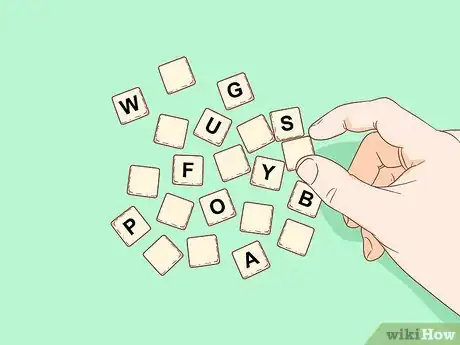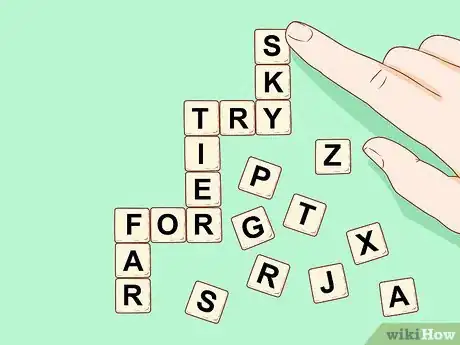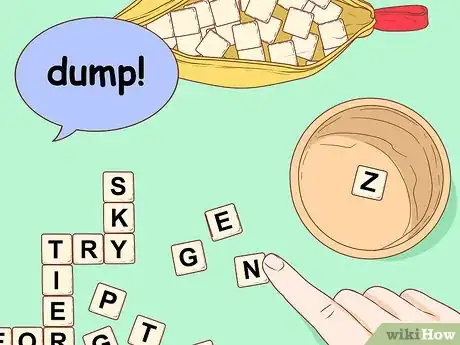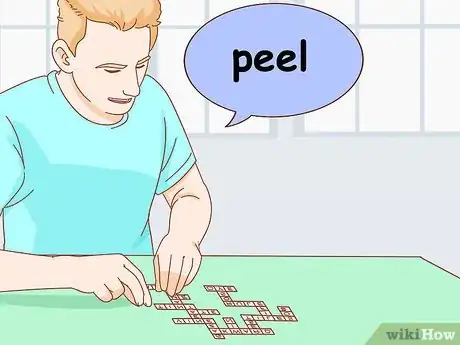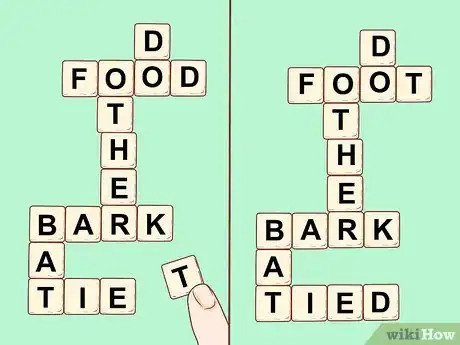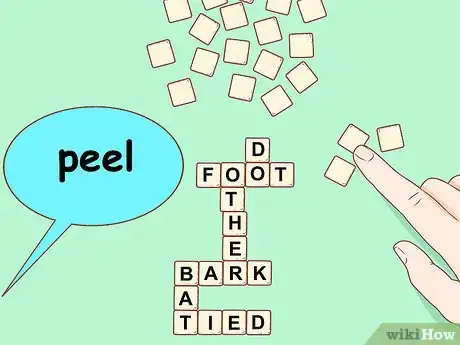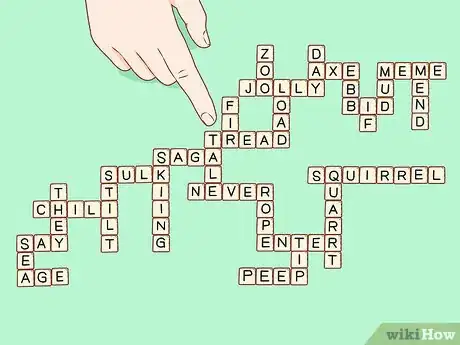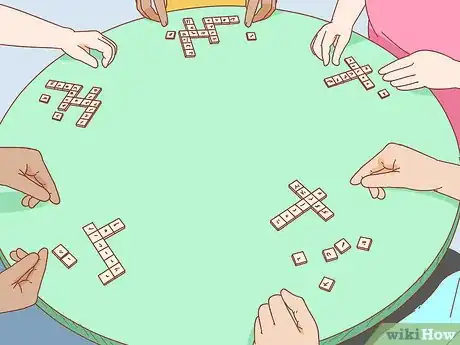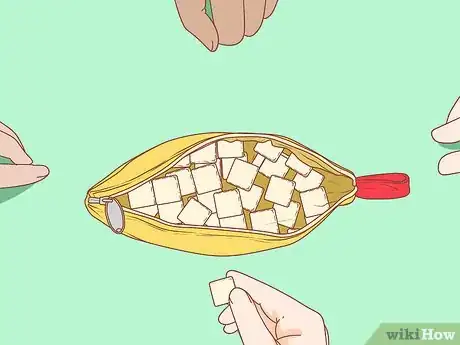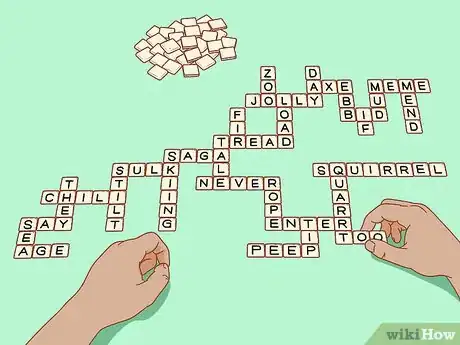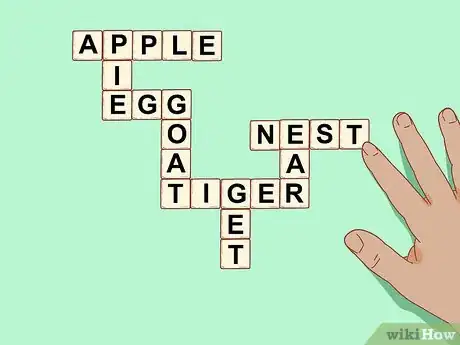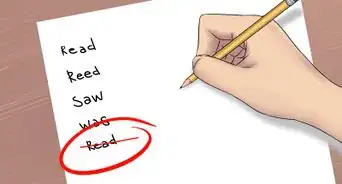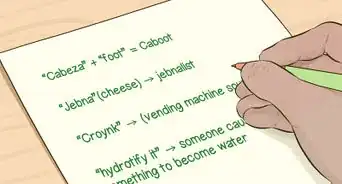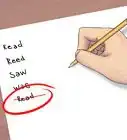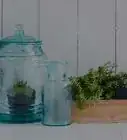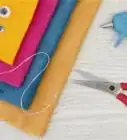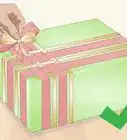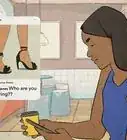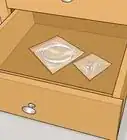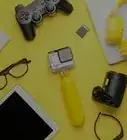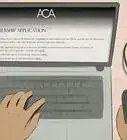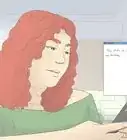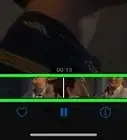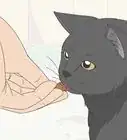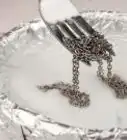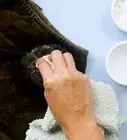This article was co-authored by wikiHow Staff. Our trained team of editors and researchers validate articles for accuracy and comprehensiveness. wikiHow's Content Management Team carefully monitors the work from our editorial staff to ensure that each article is backed by trusted research and meets our high quality standards.
wikiHow marks an article as reader-approved once it receives enough positive feedback. In this case, several readers have written to tell us that this article was helpful to them, earning it our reader-approved status.
This article has been viewed 409,690 times.
Learn more...
Bananagrams is a fast-paced, competitive word game with similarities to both Scrabble and Boggle. Like Boggle, gameplay happens quickly and doesn’t involve turns. Like Scrabble, each player builds their own interlocking grid of words until they’ve used all their letters. Try an alternate version of the game if you’re playing by yourself, or if you want to speed things up a bit!
Steps
Learning the Traditional Rules
-
1Place all the tiles facedown on a flat surface. Unzip the banana-shaped pouch and dump out all 144 letter tiles in a central spot that’s within arm’s reach of all players. It’s best to play on a hard, flat surface such as the floor or a table. No letters should be visible once you’ve flipped over all the tiles.[1]
- This group of facedown tiles is known as the “bunch.”
- Mix the letters around a bit after flipping them over to ensure that they’re randomly distributed.
-
2Each person takes a set amount of tiles, depending on the number of players. The number of starting tiles for each player is determined by the number of people playing the game. You can play Bananagrams with a minimum of 2 people and a maximum of 8.[2]
- For 2-4 players, draw 21 tiles each.
- For 5-6 people, draw 15 tiles each.
- For 7-8 people, draw 11 tiles each.
Advertisement -
3Start the game by saying "split" and flipping over your tiles. This is the signal for everyone to flip over their tiles so the letters are face-up. As you turn over your tiles, you should start thinking about words that could be formed using these letters.[3]
-
4Arrange your tiles into words that intersect like a crossword. Words can be arranged vertically or horizontally, but not diagonally. The goal is to be the first to use all of your starting letters in your word grid. You cannot use proper nouns or abbreviations.[4]
- Each player creates their own, personal word grid (unlike Scrabble, where all players add on to one group grid).
- Everyone should be playing simultaneously—there are no “turns” in Bananagrams. You are racing the other players to be the first to use all your letters.
- Consider starting off with a longer word, which gives you more opportunities to build new words.
-
5Exchange 1 letter tile for 3 new ones if you’re having trouble using it. This is called “dumping.” Many people dump tiles if they have too many vowels, too many consonants, or even just a tricky letter like an X or Q. Place the tile you are dumping back in the bunch, say “dump!” then draw 3 new tiles.
- Be sure to dump your letter far away in the pile so you don't pick it up immediately if you draw again.
-
6Say “peel” once you have used all your tiles. Every player must draw 1 new tile from the bunch. Someone else may use all their letters first, in which case you still must draw a new tile when they say “peel.”[5]
- It's always a good idea to double-check all your words are valid and spelled correctly before peeling.
- An effective strategy is to "peel" as fast as possible, several times in a row. An influx of new tiles may slow your opponents down!
-
7Incorporate the new tile into your grid of words. Tiles can be rearranged in any way you want once you’ve drawn a new tile. Once you’ve used the tile, you can yell “peel” again.
- In this example, the player has a newly drawn T. By replacing the D in FOOD with the T and creating FOOT, the player was able to place the D at the end of TIE to make TIED, effectively using all of their tiles.
- Two letter words like QI, IT, and OE are useful placeholders for new letters until you can work them into a larger word.
-
8Continue peeling until the bunch has fewer tiles than the number of players. For example: Player 1 peels, and after all 5 players have drawn a new tile, there are only 4 tiles left in the bunch. At this point, the first person to use up all their tiles in their word grid wins the game.[6]
- Sometimes, the number of tiles divides evenly among players. If this is the case, you’ll end up with no tiles left in the bunch after the final peel.
-
9Yell “bananas” if you are the first player to use up all your tiles. Since there are no more tiles in the bunch to draw, the game is now over. The player who called “Bananas!” first is the winner.[7]
- If 2 players yell “Bananas!” at the same time, you have a tie. In this case, the player with the longest word in their grid can be declared the winner—but you can also come up with another house rule to determine the tie-breaker.
-
10Inspect the winning grid for disqualifying words. If the player has used any illegal words, then someone says “Rotten banana!” and the player is disqualified. Their tiles are mixed up and added back to the bunch, and play resumes the same way.
- When the number of tiles left in the bunch is fewer than the remaining players, the first person to use up all their tiles again exclaims “Bananas!” Their grid should be inspected for disqualifying words as well. If they are all correct, this player is the winner!
Trying Alternate Versions
-
1Play with no peeling or dumping for a slower-paced version of the game. Start by dividing all the tiles equally among players. Each player flips over their tiles at the start of the game and tries to create a grid of interlocking words using all their tiles. When one player uses all their letters, they call “Bananas!” and the game is over—assuming that player doesn’t have any disqualifying words in their grid.[8]
- If the game ends in a tie or a stalemate, with no one able to use all their letters, the winner is the player with the longest word in their grid.
-
2Do not allow peeling for a very quick version of the game. Have each player draw 21 tiles from the pouch and place them face down in front of them. Then, play Bananagrams the usual way—but without peeling. Players can still dump. The first player to incorporate all 21 letters into a word grid and yell “Bananas!” is the winner.[9]
- This alternative is great for waiting in restaurants or doctor’s offices.
-
3Try a solitaire version of Bananagrams to hone your skills. Place all the tiles facedown, then flip over 21 tiles. Start a timer and play as usual, although there’s no need to call out “peel” or “dump” to alert other players. Once you’ve used all the tiles, stop the timer.[10]
- Then, repeat to see if you can beat your own best time.
- Or, challenge yourself by trying to create a grid using the fewest words possible. Look for longer, more complex words that you can play.
-
4Play cooperatively to develop concentration and reading ability. This version of Bananagrams is great for children and helps them practice their reading and spelling skills. Start by placing all the tiles face up. Then, all players help in creating one large interlocking word grid. You can take turns, or play freely and allow anyone who has an idea to play a word.[11]
- The game is over when all the tiles have been used to create one big grid. There are no winners in this version!
Community Q&A
Did you know you can get answers researched by wikiHow Staff?
Unlock staff-researched answers by supporting wikiHow
-
QuestionCan you play Bananagrams alone?
 wikiHow Staff EditorThis answer was written by one of our trained team of researchers who validated it for accuracy and comprehensiveness.
wikiHow Staff EditorThis answer was written by one of our trained team of researchers who validated it for accuracy and comprehensiveness.
Staff Answer wikiHow Staff EditorStaff Answer
wikiHow Staff EditorStaff Answer -
QuestionHow do you play Bananagrams WildTiles?
 wikiHow Staff EditorThis answer was written by one of our trained team of researchers who validated it for accuracy and comprehensiveness.
wikiHow Staff EditorThis answer was written by one of our trained team of researchers who validated it for accuracy and comprehensiveness.
Staff Answer wikiHow Staff EditorStaff Answer
wikiHow Staff EditorStaff Answer -
QuestionIs Bananagrams the same as Scrabble?
 wikiHow Staff EditorThis answer was written by one of our trained team of researchers who validated it for accuracy and comprehensiveness.
wikiHow Staff EditorThis answer was written by one of our trained team of researchers who validated it for accuracy and comprehensiveness.
Staff Answer wikiHow Staff EditorStaff AnswerBananagrams and Scrabble are both word-building games with a crossword structure, but the rules are different. Unlike in Scrabble, each player builds their own word grid, and all the players play simultaneously. The letters are not weighted differently, as they are in Scrabble, and there is more speed involved.
wikiHow Staff EditorStaff AnswerBananagrams and Scrabble are both word-building games with a crossword structure, but the rules are different. Unlike in Scrabble, each player builds their own word grid, and all the players play simultaneously. The letters are not weighted differently, as they are in Scrabble, and there is more speed involved.
Things You'll Need
- Table or floor
- 2-8 players
- Bananagrams tiles
References
- ↑ https://bananagrams.com/blog/how-to-play-bananagrams-instructions-for-getting-started
- ↑ https://www.fgbradleys.com/rules/Bananagrams%20Rules.pdf
- ↑ https://bananagrams.com/blog/how-to-play-bananagrams-instructions-for-getting-started
- ↑ https://bananagrams.com/blog/how-to-play-bananagrams-instructions-for-getting-started
- ↑ https://www.fgbradleys.com/rules/Bananagrams%20Rules.pdf
- ↑ https://bananagrams.com/blog/how-to-play-bananagrams-instructions-for-getting-started
- ↑ https://bananagrams.com/blog/how-to-play-bananagrams-instructions-for-getting-started
- ↑ https://bananagrams.com/blog/how-to-play-bananagrams-instructions-for-getting-started
- ↑ https://bananagrams.com/blog/how-to-play-bananagrams-instructions-for-getting-started
About This Article
To play Bananagrams, start by flipping all the tiles face down on a flat surface. Then, have each player take their tiles for the game. If you're playing with 2 to 4 players, draw 21 tiles each. For 5 to 6 players, draw 15 tiles each. Group the leftover tiles in a middle pile, then yell "Split!" Have everyone flip over their tiles simultaneously and arrange them in words on the table. Everyone's words should intersect, like a crossword, but they can't go diagonally. Once you run out of tiles, yell "Peel!" and have everyone draw a new tile, including yourself. Keep playing until the middle pile has fewer tiles than the number of players. Then, whoever runs out of tiles first wins! To learn how to play Bananagrams by yourself, scroll down!
